

Voyager 1 Ephemeris Calculator
Compute the position of Voyager 1 for any date and time between 1 January 2013 and 30 December 2099 and display the results on an interactive star map.
In Evidence
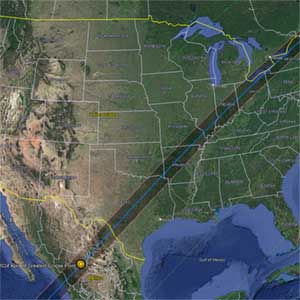
Voyager 1 is a space probe launched by NASA on September 5, 1977, to study the outer Solar System and beyond. It is currently the most distant human-made object from Earth, having traveled over 14 billion miles (23 billion kilometers) from the Sun. Voyager 1's mission has included flybys of Jupiter and Saturn, with the goal of studying their moons, rings, and magnetic fields. The probe is now traveling through the heliosheath , the outermost layer of the Sun's heliosphere, and is expected to enter interstellar space in the coming years. Voyager 1 carries a golden record that contains sounds and images selected to portray the diversity of life and culture on Earth, in the event that it is ever encountered by extraterrestrial life.
Voyager 1 is currently in the constellation of Ophiucus , at a distance of 24,330,412,063 kilometers from Earth.

Today's rise, transit and set times of Voyager 1 from Greenwich, United Kingdom edit_location_alt (all times relative to the local timezone Europe/London):
- Voyager 1 is above the horizon from Greenwich, United Kingdom edit_location_alt .
- Right now it is placed in the East-South-East direction at an altitude of 30° above the horizon.
- Go to interactive sky chart
If you need to access this information frequently for your observations, you can create a simple customized Quick Access page , so that you can easily bookmark it in your browser favorites or add a shortcut to your mobile phones' home screen.
- Position and finder charts (see also Where is Voyager 1? )
- Distance from Earth (see also How far is Voyager 1 from Earth? )
- When does Voyager 1 rise and set?
- Interactive orbit visualization . 3d visualization showing the orbit of Voyager 1 with respect to the major Solar System objects.
- 15 days ephemerides . Table showing celestial coordinates and magnitude of Voyager 1 for the past and next 7 days.
- Interactive sky chart . An online planetarium application that shows where to locate Voyager 1 in the sky from your location.
- Live position tracker . A high precision sky chart that uses real deep sky imagery to help locate Voyager 1 with your telescope or on your astrophotographies.
Voyager 1 Position and Finder Charts

Higher precision deep sky finder chart, 60 arcmin wide, showing where Voyager 1 is right now. Click on the image to see a more detailed fullscreen tracker view .

Also check out Where is Voyager 1? , a page that provides all the information needed to find Voyager 1 in the sky and additional links to sky charts.
Voyager 1 Distance from Earth
The distance of Voyager 1 from Earth is currently 24,330,412,063 kilometers, equivalent to 162.638759 Astronomical Units . Light takes 22 hours, 32 minutes and 37.5189 seconds to travel from Voyager 1 and arrive to us.
The following chart shows the distance of Voyager 1 from Earth as a function of time. In the chart the distance data is measured in Astronomical Units and sampled with an interval of 1 day.
Closest Approach of Voyager 1 to Earth
NOTE: values for the closest approach are computed with a sampling interval of 1 day.
Visualization of Voyager 1 Orbit
This 3d orbit diagram is a feature of our 3D Solar System Simulator and shows the orbit of Voyager 1 with respect of the Sun and the orbits of the major planets . The position of Voyager 1 and the planets along their orbits in this diagram accurately represents the current configuration of the objects in the Solar System. This is an experimental feature and it requires a WebGL enabled browser. Please provide us feedback !
Voyager 1 15 Days Ephemeris
The following table lists the ephemerides of Voyager 1 computed for the past and next 7 days, with a 24 hours interval. Click on each row of the table to locate Voyager 1 in our Online Planetarium at the chosen date.

Interstellar Messengers
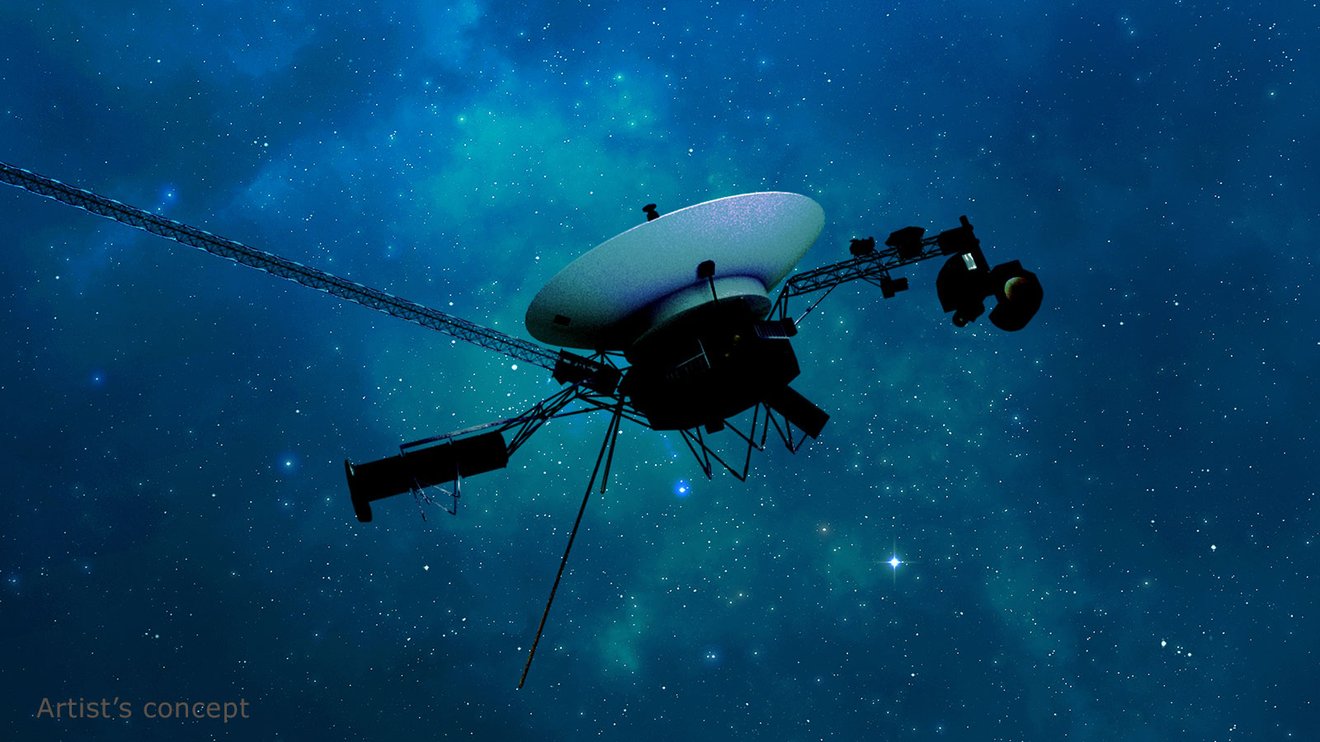
Voyager 1 and its twin Voyager 2 are the only spacecraft ever to operate outside the heliosphere, the protective bubble of particles and magnetic fields generated by the Sun. Voyager 1 reached the interstellar boundary in 2012, while Voyager 2 (traveling slower and in a different direction than its twin) reached it in 2018.
Mission Type
Science Targets
Latest News
NASA’s Voyager Team Focuses on Software Patch, Thrusters
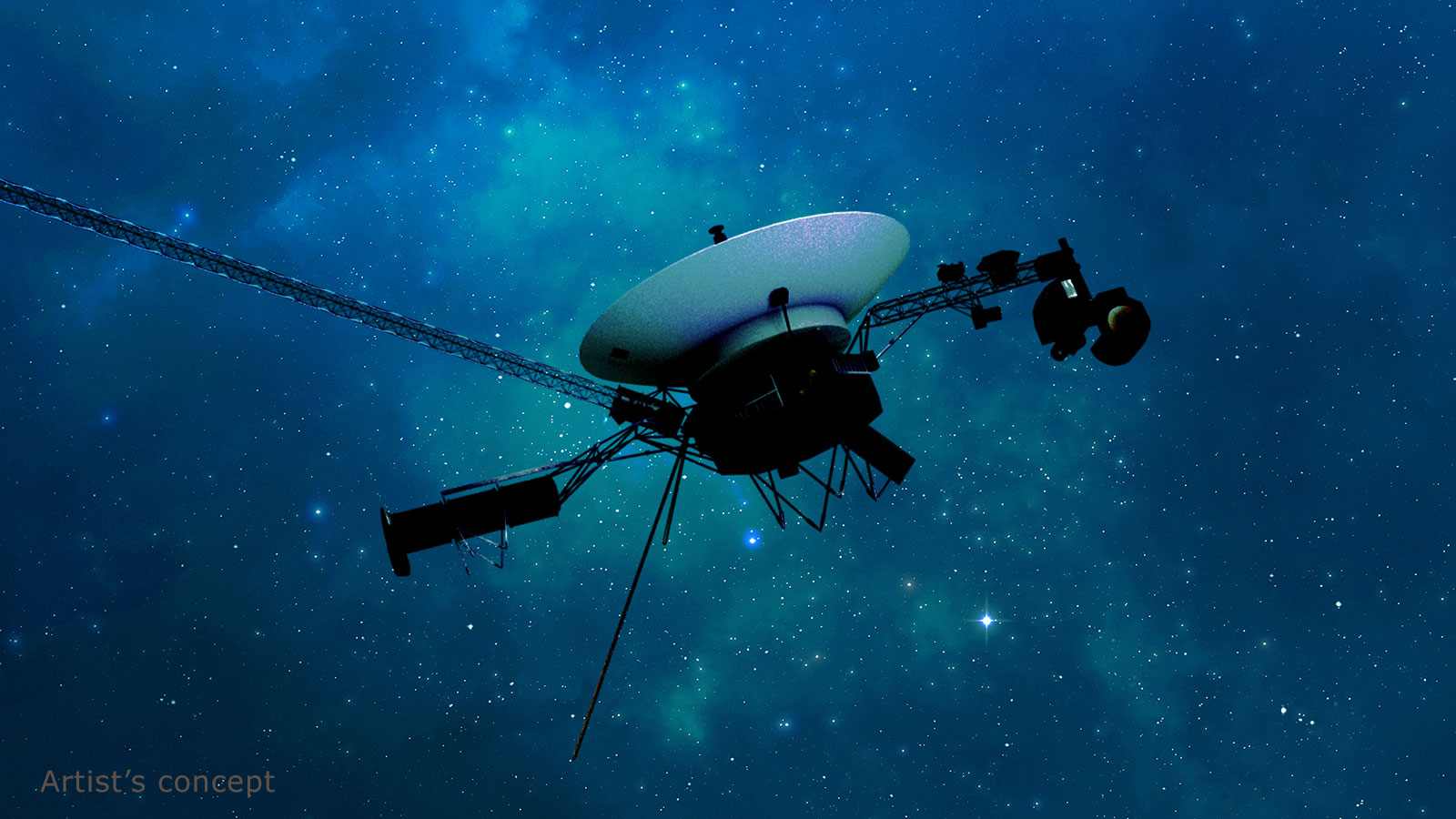
NASA’s Voyager Will Do More Science With New Power Strategy
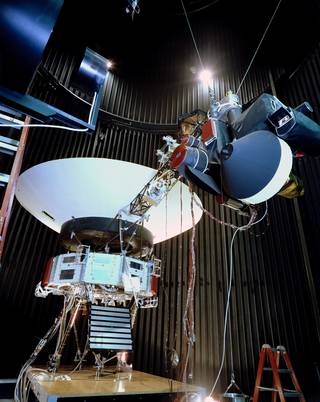
Edward Stone Retires After 50 Years as NASA Voyager’s Project Scientist
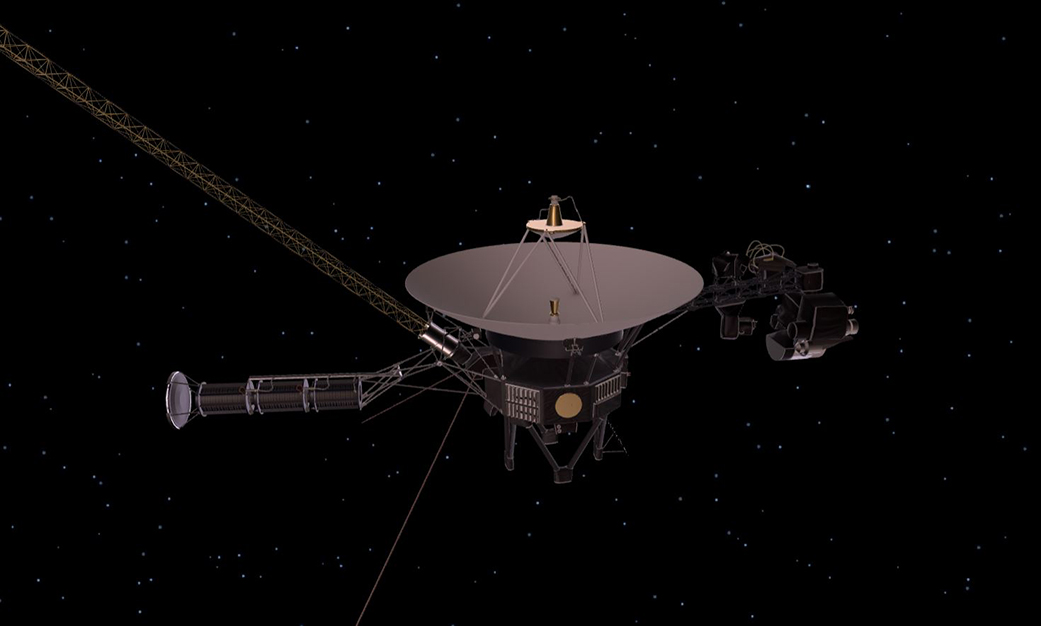
Engineers Solve Data Glitch on NASA’s Voyager 1
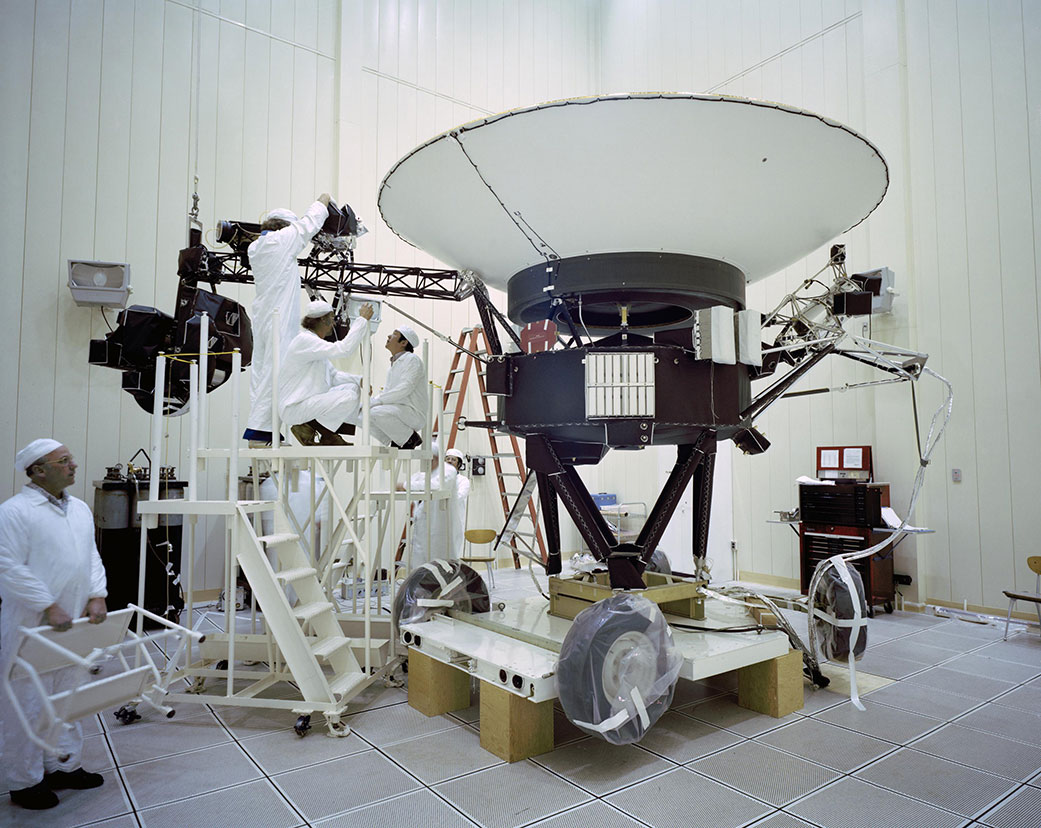
Voyager, NASA’s Longest-Lived Mission, Logs 45 Years in Space
The Interstellar Mission
After completing the first in-depth reconnaissance of the outer planets, the twin Voyagers are on a new mission to chart the edge of interstellar space.
The Golden Record
The contents of the golden record were selected for NASA by a committee led by Carl Sagan of Cornell University.
The Spacecraft
The twin Voyagers are escaping our solar system in different directions at more than 3 astronomical units (AU) a year.
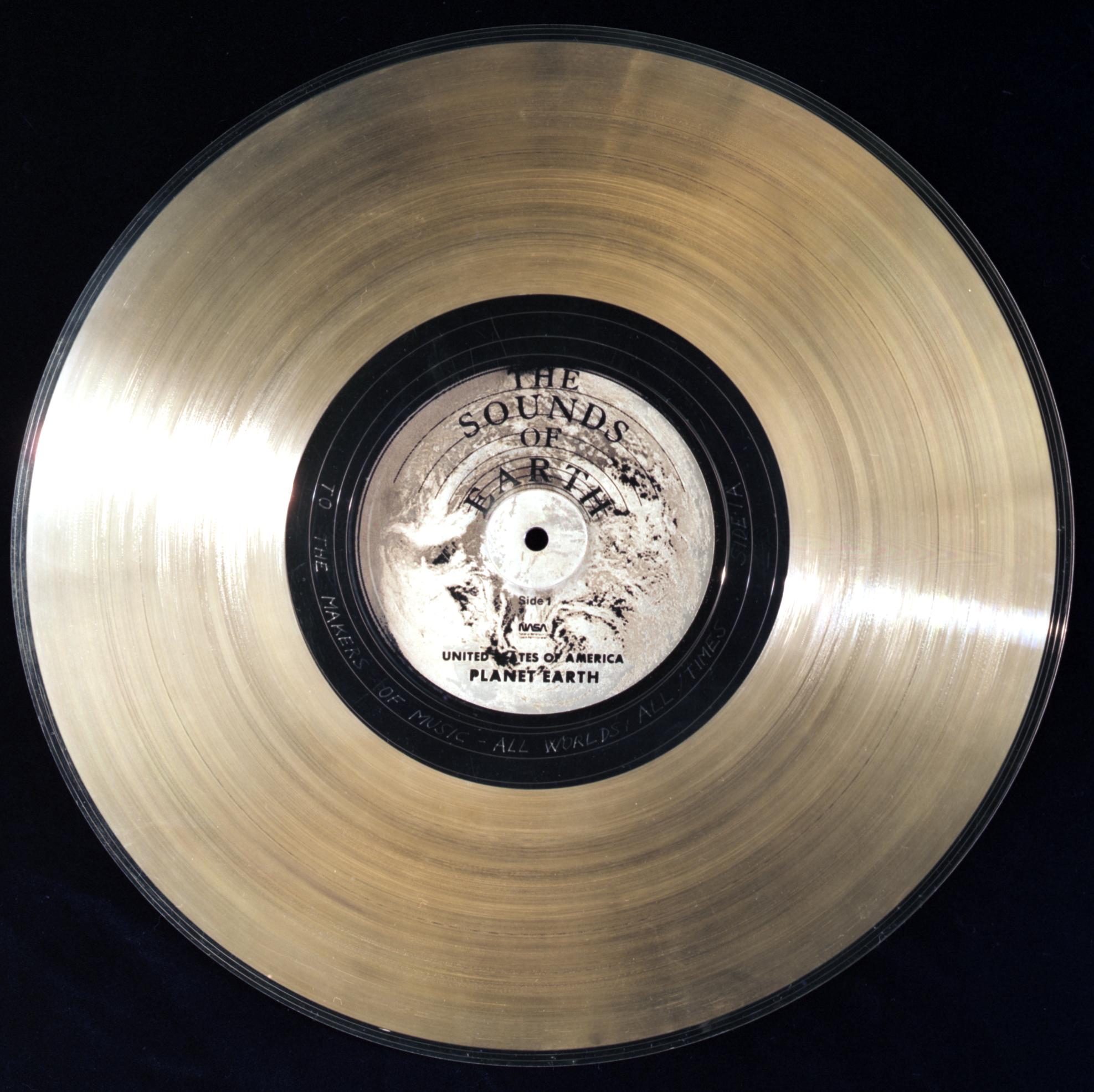
The Pale Blue Dot
The behind-the-scenes story of the making of Voyager 1's iconic image of Earth as "a mote of dust suspended in a sunbeam."
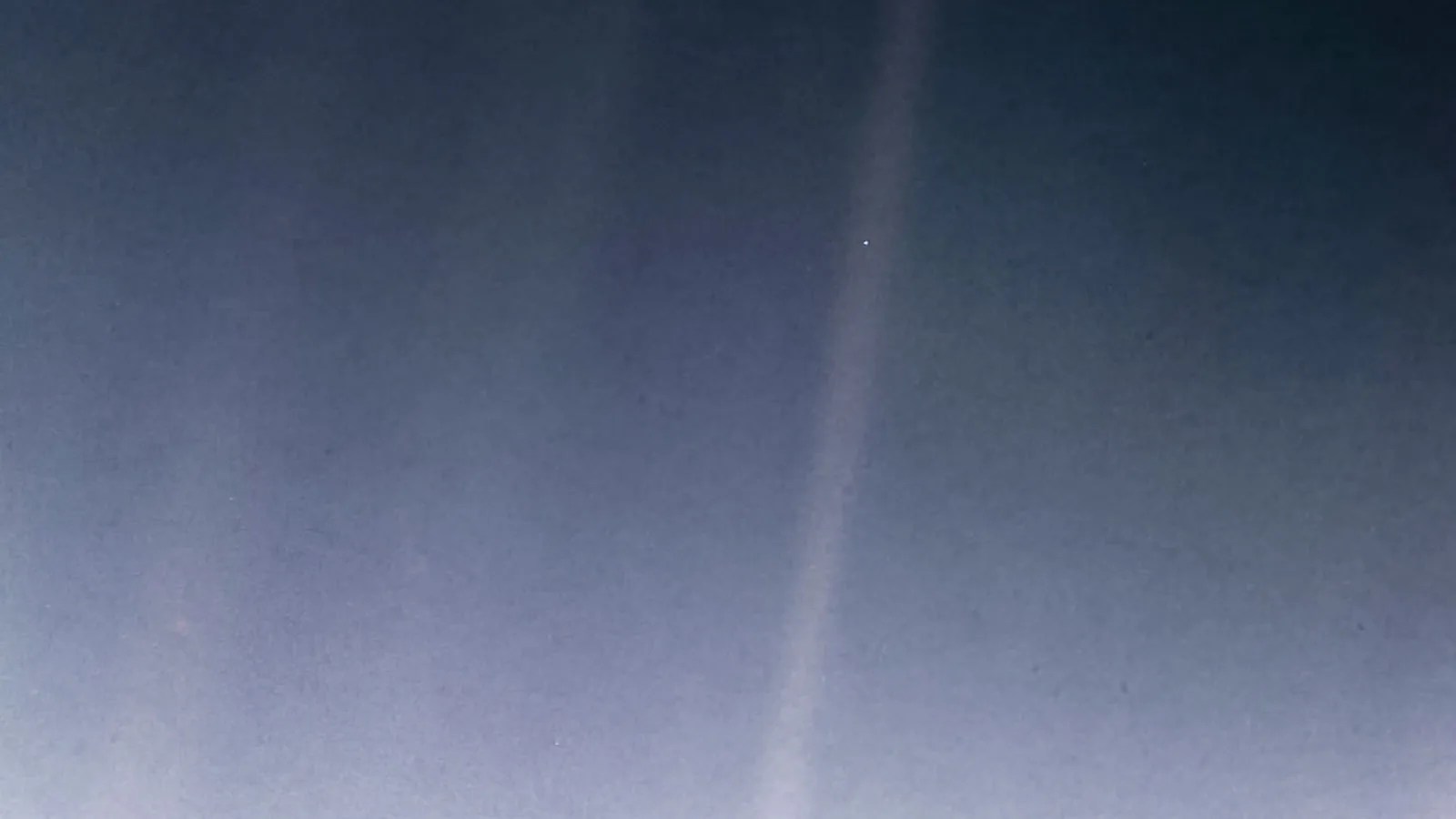
Discover More Topics From NASA

Our Solar System

Heliosphere
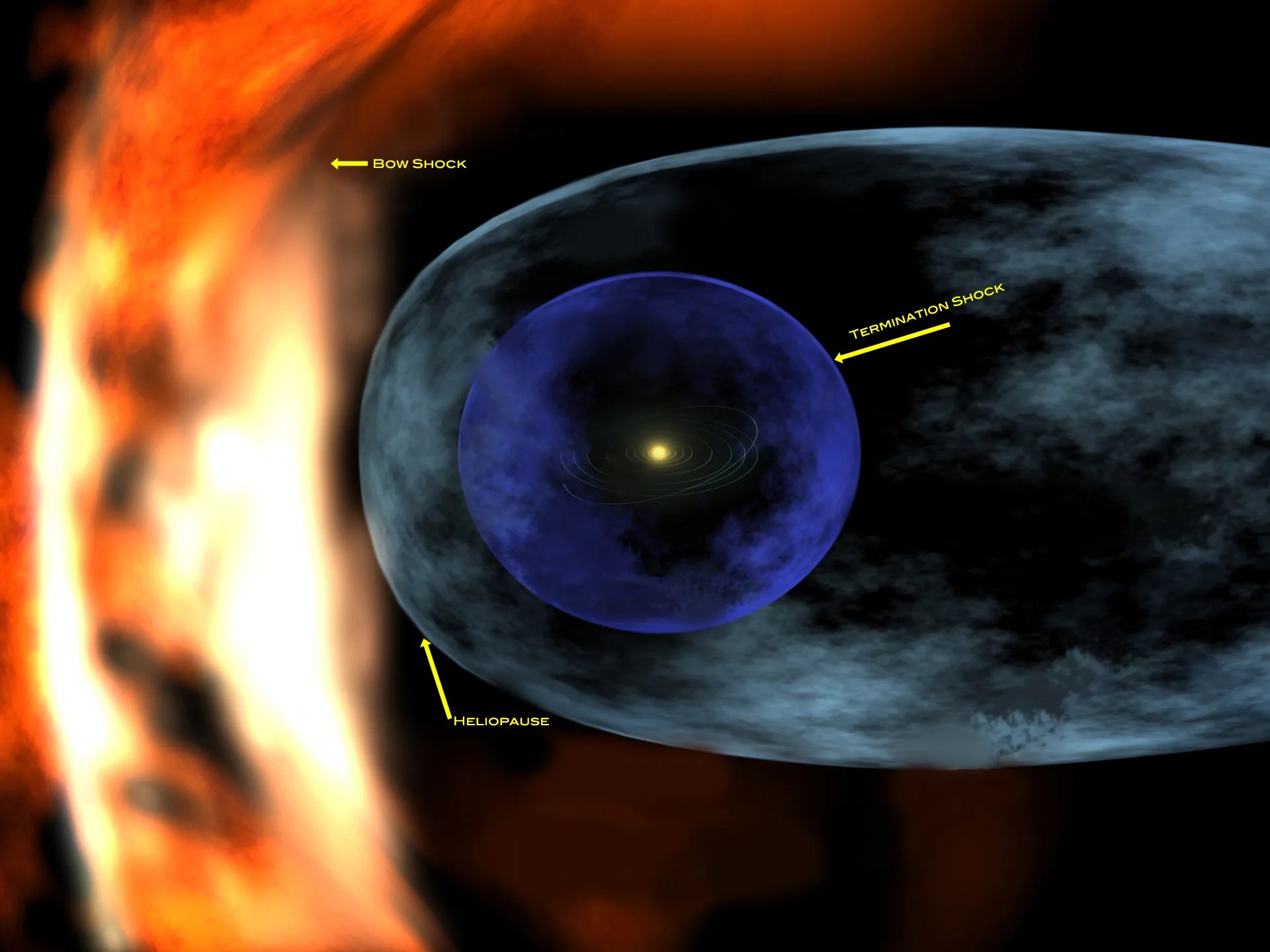
NASA Voyager Status Update on Voyager 1 Location

The consensus of the Voyager science team is that Voyager 1 has not yet reached interstellar space.
News Media Contact
Jia-Rui Cook
Jet Propulsion Laboratory, Pasadena, Calif.
818-354-0724
Voyager 1 Trajectory through the Solar System
- Released Thursday, August 31, 2017
- Visualizations by:
- Tom Bridgman
This visualization tracks the trajectory of the Voyager 1 spacecraft through the solar system. Launched on September 5, 1977, it was one of two spacecraft sent to visit the giant planets of the outer solar system. Voyager 1 flew by Jupiter and Saturn before being directed out of the solar system. To fit the 40 year history of the mission into a short visualization, the pacing of time accelerates through most of the movie, starting at about 5 days per second at the beginning and speeding up to about 11 months per second after the planet flybys are past. The termination shock and heliopause are the 'boundaries' created when the plasma between the stars interacts with the plasma flowing outward from the Sun. They are represented with simple grid models and oriented so their 'nose' is pointed in the direction (Right Ascension = 17h 24m, declination = 17 degrees south) represented by more recent measurements from other missions.
Visualization centered on the Voyager 1 trajectory through the solar system.
- Voyager.ChaseV1.HD1080i_p30.mp4 (1920x1080) [120.3 MB]
- Voyager.ChaseV1.HD1080i_p30.webm (1920x1080) [15.4 MB]
- Voyager.ChaseV1.clockSlate_2160p30.mp4 (3840x2160) [210.8 MB]
- frames/1920x1080_16x9_30p/Voyager.ChaseV1.clockSlate/ (1920x1080) [256.0 KB]
- frames/3840x2160_16x9_30p/Voyager.ChaseV1.clockSlate/ (3840x2160) [256.0 KB]
- Voyager.ChaseV1.clockSlate_Track.HD1080i.03905_print.jpg (1024x576) [96.8 KB]
- Voyager.ChaseV1.clockSlate_Track.HD1080i.03905_searchweb.png (320x180) [68.6 KB]
- Voyager.ChaseV1.clockSlate_Track.HD1080i.03905_thm.png (80x40) [4.4 KB]
Voyager 1's 'Family Portrait' On Valentine's Day 1990, Voyager 1's camera were pointed back at the solar system to image the planets. Check out Voyager at NASA/JPL for more information.
- Voyager.ChaseV1.clockSlate_Track.UHD3840.00000_print.jpg (1024x576) [104.9 KB]
Opening view of Earth orbit looking outward to the rest of the solar system.
- Voyager.ChaseV1.clockSlate_Track.UHD3840.00550_print.jpg (1024x576) [117.4 KB]
Voyager 1 (and 2) cross the orbit of Mars, slightly above the ecliptic plane to avoid the asteroid belt between Mars & Jupiter.
- Voyager.ChaseV1.clockSlate_Track.UHD3840.01490_print.jpg (1024x576) [113.3 KB]
The camera moves out ahead of the Voyagers for a view back at the inner solar system.
- Voyager.ChaseV1.clockSlate_Track.UHD3840.01990_print.jpg (1024x576) [102.3 KB]
Voyager 1 just after the Jupiter flyby on March 5, 1979.
- Voyager.ChaseV1.clockSlate_Track.UHD3840.02420_print.jpg (1024x576) [101.8 KB]
Voyager 1 just before the Saturn flyby on November 12, 1980.
- Voyager.ChaseV1.clockSlate_Track.UHD3840.02990_print.jpg (1024x576) [123.1 KB]
With a gravity-assist from the Saturn flyby, Voyager 1 is directed above the plane of the solar system and continues outward. This is near the time of the Voyager 1 'Family Portrait'. The orbit of Pluto is the grey orbit visible above the orbits of the other planets.
- Voyager.ChaseV1.clockSlate_Track.UHD3840.03350_print.jpg (1024x576) [97.5 KB]
Voyager 1 crosses the termination shock of the solar wind. For simplified and symmetric termination shock model, the timing is not accurate. In reality, this crossing occurred around December of 2004.
- Voyager.ChaseV1.clockSlate_Track.UHD3840.03900_print.jpg (1024x576) [99.4 KB]
Voyager 1 (and 2) beyond the heliopause near the end of 2017.
A slightly sped-up version of the Voyager 1 visualization above, reducing the time for the Voyagers to cross the asteroid belt.
- Voyager1SpedUp.m4v (1920x1080) [123.0 MB]
- Voyager1SpedUp.webm (1920x1080) [12.2 MB]
- Voyager1_Sped_Up-HD1080p.mov (1920x1080) [185.8 MB]
- Voyager1_Sped_Up.mov (1920x1080) [1.7 GB]
- Voyager_1_Sped_Up_4k-H264.mov (3840x2160) [639.6 MB]
- Voyager_1_Sped_Up_4k_ProRes.mov (3840x2160) [7.2 GB]
- Voyager1SpedUp.00500_print.jpg (1024x576) [122.6 KB]
- Solar System
Please give credit for this item to: NASA's Scientific Visualization Studio
- Tom Bridgman (Global Science and Technology, Inc.)
- Kathalina Tran (KBR Wyle Services, LLC)
- Genna Duberstein (USRA)
- Scott Wiessinger (USRA)
Project support
- Laurence Schuler (ADNET Systems, Inc.)
- Ian Jones (ADNET Systems, Inc.)
Release date
This page was originally published on Thursday, August 31, 2017. This page was last updated on Wednesday, November 15, 2023 at 12:05 AM EST.
- Voyager @ 40
- Voyager Retrospective
Datasets used in this visualization
Planetary ephemerides SPICE kernel
Note: While we identify the data sets used in these visualizations, we do not store any further details, nor the data sets themselves on our site.
Hubble’s Brand New Image of Jupiter
Where is the edge of the solar system, voyager 2 trajectory through the solar system, revisiting the pale blue dot at 30, you may also like..., no results., an error occurred. please reload this page and try again..
The 5 stages of the 2024 total solar eclipse explained for April 8
On Monday (April 8), a total solar eclipse will sweep across the Americas. Here's how it will play out.
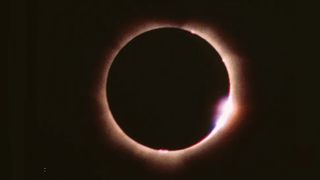
Stage 1: First contact
Stage 2: second contact, stage 3: totality, stage 4: third contact, stage 5: fourth contact.
On Monday, April 8, the 2024 total solar eclipse will sweep through the sky over North America.
While all of North America and Central America will experience at least a partial solar eclipse , those within a path with a width of approximately 115 miles (185 kilometers) passing over 15 U.S. States. Mexico, and Canada will also witness a totality as the moon entirely covers the disk of the sun.
You can watch the total solar eclipse live on Space.com . You can also keep up with all the eclipse-related action with our total solar eclipse 2024 live updates blog.
Don't be in the dark about the 2024 total eclipse
There are three major types of solar eclipse. A total solar eclipse like that on April 8 occurs when the moon is relatively close to Earth and blocks the entire disk of the sun.
Because the moon's orbit around our planet is an ellipse, sometimes it is further away and thus appears smaller. An eclipse at these times sees the moon only an obscure part of the solar disk, with the sun appearing as a glowing ring of fire. These events are called annular solar eclipses , and the last one seen over the U.S. occurred on Oct. 14, 2023.
Finally, a partial solar eclipse is an event that happens when the Earth, moon, and sun are not perfectly aligned, resulting in the lunar disk only covering part of our star, making the sun appear as if a bite has been taken out of it. Partial eclipses also happen at the beginning and ending stages of total and annular eclipses.
On April 8, 2024, the moon will be in its new moon phase , and it will look relatively large, meaning it is capable of covering 100% of the sun's disk as viewed from the narrow path of totality. The fraction of the diameter of the sun covered by the moon is known as the magnitude of a solar eclipse . On April 8, 2024, this value will be 1.0566, according to EclipseWise.com , slightly more than total coverage.

Get the Space.com Newsletter
Breaking space news, the latest updates on rocket launches, skywatching events and more!
NASA has released an interactive map of the total eclipse, which space enthusiasts can use to track the totality as it drifts across the globe. However, location won't be the only factor affecting the appearance of the total solar eclipse on Monday. The eclipse will pass through 5 distinct stages, with each of these phases occurring at different times across different locations.
What are the stages of the annular solar eclipse?
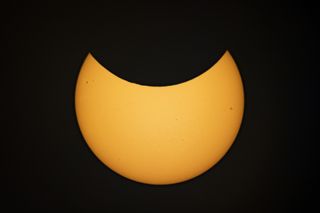
In the initial stage of the eclipse, the moon will begin to pass in front of the sun, kick-starting a partial solar eclipse. During this phase, the darkened lunar disk of the moon will make the sun appear as if a bite has been taken out of its illuminated face. This "bite" will get bigger and bigger as the totality approaches.
During the first stage of the total solar eclipse, some onlookers will be able to see rapidly moving, long, dark bands called " shadow bands " on the sides of buildings or the ground. Bailey's beads , caused by light streaming through the valleys on the horizon of the moon, may also be visible at the moon's edges during this initial stage. These phenomena repeat during the second partial eclipse that occurs after totality.
On April 8, this stage of the partial eclipse will first be seen near Pu‘uali‘i, Hawaii, at 6:27 a.m. local time (12:27 p.m. EDT, 1627 GMT).

First contact will last for between 70 and 80 minutes, and its conclusion will be marked by a single bright spot, or " diamond ring ," appearing at the edge of the moon. This marks the second contact stage and heralds the oncoming totality.
On April 8, the total solar eclipse will make landfall at Mazatlán, Sinaloa, Mexico, at 9:51 a.m. local time (12:51 p.m. EDT, 16:51 GMT).
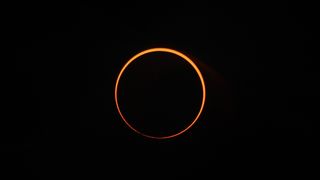
Stage 3 and the mid-point of the total solar eclipse is the totality. At this point, the moon completely covers the solar disk. During the totality of the outer atmosphere of the sun, the corona may become visible as white streamers at the edge of the moon. This region is usually washed out by bright light from the solar surface, the photosphere. The inner atmosphere of the sun, the chromosphere , may be visible as a wispy aura around the edge of the moon.
The totality may also make stars and planets visible in the darkened sky that are usually not visible from America during daylight hours.
On April 8, the first location to experience totality will be Mazatlán, Sinaloa, Mexico at 11:07 a.m. local time (2:07 p.m. EDT, 1807 GMT). The first location to experience totality in the U.S. will be Near Florentino Ramos Colonia, Texas, at 1:27 p.m. local time (2:27 p.m. EDT, 1827 GMT).
The duration of the totality depends on the path from which the eclipse is viewed. In Mexico, totality will last for 40 minutes and 43 seconds. Skywatchers in the U.S. will collectively experience totality for 67 minutes and 58 seconds. Onlookers in Canada will experience the totality of the solar eclipse for 34 minutes and 4 seconds.

The fourth stage of the total solar eclipse, third contact, will see the moon start to move away from the disk of the sun, thus ending the totality and starting the second partial eclipse period. Brightening appears on the opposite side of the moon as it did during the second contact period. At this time, skywatchers will get another chance to spot Baily's Beads along the edge of the moon and shadow bands on the buildings and ground around them, with this stage mirroring the second contact stage.
The total solar eclipse ends on the Atlantic coast at 5:16 p.m. local time (3:46 p.m. EDT, 1946 GMT).
The fifth and final stage of the total solar eclipse. The moon moves away from the disk of the sun, meaning that at fourth contact, the moon is no longer even partially eclipsing the sun. At this point, 2024's total solar eclipse will be over.
On April 8, on the Atlantic coast of Newfoundland and Labrador, the partial eclipse phase ends at 6:18 p.m. local time (4:48 p.m. EDT, 2048 GMT).
— A 'horned' comet may be visible during the 2024 total solar eclipse
— How photos of the April 8 solar eclipse will help us understand of the sun's atmosphere
— How fast will April's total solar eclipse travel?
If you intend to view any of these stages, the most important thing to consider is how to safely view it. Looking at the sun without adequate protection at any time is harmful to the eyes, so eclipse watchers should take precautions on Monday.
Sunglasses, regardless of how dark they are, can't protect the eyes from the effect of the sun, so specialized eclipse glasses made from safe solar filter materials will be needed. If skywatchers intend to watch the event with a telescope, special filters will be needed to make this a safe viewing experience.
Our how to observe the sun safely guide tells you everything you need to know about safe solar observations.
Following the 2024 total solar eclipse, skywatchers in the U.S. will next get the opportunity to see a total solar eclipse on March 30, 2033 . The totality of this eclipse, which will last 2 minutes 37 seconds, will be visible in Alaska. Following this, on Aug. 23, 2044 , a total solar eclipse will be visible from the U.S. states of Montana, South Dakota, and North Dakota, as well as from much of Canada.
Under a year later, on Aug.12, 2045 , another total solar eclipse will sweep over the U.S., visible from California, Nevada, Utah, Colorado, New Mexico, Oklahoma, Kansas, Texas, Arkansas, Missouri, Mississippi, Louisiana, Alabama, Georgia, and Florida, as well as from the Caribbean, and South America.
Submit your photos! If you capture a photo of the April 8 total solar eclipse and would like to share it with Space.com's readers, send photos, videos, comments, and your name, location and content usage permission release to [email protected] .
Join our Space Forums to keep talking space on the latest missions, night sky and more! And if you have a news tip, correction or comment, let us know at: [email protected].

Robert Lea is a science journalist in the U.K. whose articles have been published in Physics World, New Scientist, Astronomy Magazine, All About Space, Newsweek and ZME Science. He also writes about science communication for Elsevier and the European Journal of Physics. Rob holds a bachelor of science degree in physics and astronomy from the U.K.’s Open University. Follow him on Twitter @sciencef1rst.
What it was like to chase totality in South Texas
Astronauts' photos capture April 8 solar eclipse from Earth orbit
Why Peter Higgs leaves a massive legacy in the field of physics
Most Popular
By Harry Baker April 10, 2024
By Robert Lea April 10, 2024
By Daisy Dobrijevic April 10, 2024
By Mike Wall April 10, 2024
By Elizabeth Howell April 09, 2024
By Daisy Dobrijevic April 09, 2024
By Robert Lea April 09, 2024
By Josh Dinner April 09, 2024
By Robert Z. Pearlman April 09, 2024
By Mike Wall April 09, 2024
By Keumars Afifi-Sabet April 09, 2024
- 2 See Jupiter close to a crescent moon (Mars near Saturn, too) in the 'View a Planet Day' night sky
- 3 What happened when the moon 'turned itself inside out' billions of years ago?
- 4 Could these big expandable habitats help humanity settle the moon and Mars?
- 5 US needs new space tech or it 'will lose,' Space Force chief says
- Group booking
- Hotels in Moscow
- Apartments in Moscow
- USD U.S. dollar
- GBP Pound sterling
- AUD Australian dollar
- CAD Canadian dollar
- BRL Brazilian real
- BGN Bulgarian lev
- CNY Chinese yuan
- CZK Czech koruna
- DKK Danish krone
- HKD Hong Kong dollar
- ILS Israeli new sheqel
- JPY Japanese yen
- MYR Malaysian ringgit
- NZD New Zealand dollar
- NOK Norwegian krone
- PLN Polish zloty
- RON Romanian leu
- RUB Russian ruble
- SAR Saudi riyal
- SGD Singapore dollar
- ZAR South African rand
- KRW South Korean won
- SEK Swedish krona
- CHF Swiss franc
- TRY Turkish lira
- UAH Ukrainian hryvnia
- THB Thai baht
- Privacy statement
Hotel Voyager Moscow

Tourist attractions in
- Frolov Gallery - 50 m
- Institute of Russian Realist Art - 200 m
- Diver Lighthouse - 400 m
- Krutitsy Metochion - 650 m
- Brooklyn Hall - 550 m
- Church of the Holy Trinity - 300 m
- Krutitskoe Podvorye - 700 m
- Museum of Travel and Pilgrimage to Holy Places - 650 m
- Russian Valenki Museum - 300 m
- Church of the Assumption of the Blessed Virgin - 700 m
- Vnukovo International - 32 km
- Paveletsky Train Station - 900 m
Prices & Availability
Room Amenities
- Ironing facilities
- Flat-screen TV
- AM/FM alarm clock
- Carpeted floor
- ✈ What is the nearest airport to Hotel Voyager Moscow? The nearest airport is Vnukovo International and it is placed within 36 minutes' drive.
- ❓ What is the cancellation policy in Hotel Voyager? Hotel Voyager provides free cancellation.
- 🕑 What time can we access our room at Hotel Voyager Moscow? Suggested arrival time in Hotel Voyager Moscow is 14:00.
- 🕗 What time should we leave our room at Hotel Voyager Moscow? Departure time at Hotel Voyager Moscow starts at 12:00.
- 🌇 How far is Hotel Voyager from the city centre? Hotel Voyager is set within 5 km from the city centre.
- 📧 Does Hotel Voyager Moscow have a Wi-Fi network? Yes, Hotel Voyager Moscow offers WiFi throughout the property.
- ❓ Can Hotel Voyager arrange airport transfer? Unfortunately, Hotel Voyager doesn't offer airport shuttle service. Please contact the hotel representatives for more details.
- ❓ How can we pay in Hotel Voyager? At Hotel Voyager you can pay with American Express, Mastercard and Visa.
- 💵 What is the price of a room in Hotel Voyager? The price of a room at Hotel Voyager starts at $61.

Travelling to Moscow?
Find your perfect place to stay!
Great locations and deals for every budget.
V. I. Lenin
The tasks of the working women’s movement in the soviet republic, speech delivered at the fourth moscow city conference of non-party working women, september 23, 1919.
Delivered: 23 September, 1919 First Published: Pravda No. 213, September 25, 1919 ; Published according to the text of the pamphlet, V. I. Lenin, Speech at the Working Women’s Congress, Moscow, 1919, verified with the Pravda text Source: Lenin’s Collected Works , 4th English Edition, Progress Publishers, Moscow, 1965, Volume 30, pages 40-46 Translated: George Hanna Transcription/HTML Markup: David Walters & Robert Cymbala Copyleft: V. I. Lenin Internet Archive (www.marx.org) 2002. Permission is granted to copy and/or distribute this document under the terms of the GNU Free Documentation License
Comrades, it gives me pleasure to greet a conference of working women. I will allow myself to pass over those subjects and questions that, of course, at the moment are the cause of the greatest concern to every working woman and to every politically-conscious individual from among the working people; these are the most urgent questions—that of bread and that of the war situation. I know from the newspaper reports of your meetings that these questions have been dealt with exhaustively by Comrade Trotsky as far as war questions are concerned and by Comrades Yakovleva and Svidersky as far as the bread question is concerned; please, therefore, allow me to pass over those questions.
I should like to say a few words about the general tasks facing the working women’s movement in the Soviet Republic, those that are, in general, connected with the transition to socialism, and those that are of particular urgency at the present time. Comrades, the question of the position of women was raised by Soviet power from the very beginning. It seems to me that any workers’ state in the course of transition to socialism is laced with a double task. The first part of that task is relatively simple and easy. It concerns those old laws that kept women in a position of inequality as compared to men.
Participants in all emancipation movements in Western Europe have long since, not for decades but for centuries, put forward the demand that obsolete laws be annulled and women and men be made equal by law, but none of the democratic European states, none of the most advanced republics have succeeded in putting it into effect, because wherever there is capitalism, wherever there is private property in land and factories, wherever the power of capital is preserved, the men retain their privileges. It was possible to put it into effect in Russia only because the power of the workers has been established here since October 25, 1917. From its very inception Soviet power set out to be the power of the working people, hostile to all forms of exploitation. It set itself the task of doing away with the possibility of the exploitation of the working people by the landowners and capitalists, of doing away with the rule of capital. Soviet power has been trying to make it possible for the working people to organise their lives without private property in land, without privately-owned factories, without that private property that everywhere, throughout the world, even where there is complete political liberty, even in the most democratic republics, keeps the working people in a state of what is actually poverty and wage-slavery, and women in a state of double slavery.
Soviet power, the power of the working people, in the first months of its existence effected a very definite revolution in legislation that concerns women. Nothing whatever is left in the Soviet Republic of those laws that put women in a subordinate position. I am speaking specifically of those laws that took advantage of the weaker position of women and put them in a position of inequality and often, even, in a humiliating position, i.e., the laws on divorce and on children born out of wedlock and on the right of a woman to summon the father of a child for maintenance.
It is particularly in this sphere that bourgeois legislation, even, it must be said, in the most advanced countries, takes advantage of the weaker position of women to humiliate them and give them a status of inequality. It is particularly in this sphere that Soviet power has left nothing whatever of the old, unjust laws that were intolerable for working people. We may now say proudly and without any exaggeration that apart from Soviet Russia there is not a country in the world where women enjoy full equality and where women are not placed in the humiliating position felt particularly in day-to-day family life. This was one of our first and most important tasks.
If you have occasion to come into contact with parties that are hostile to the Bolsheviks, if there should come into your hands newspapers published in Russian in the regions occupied by Koichak or Denikin, or if you happen to talk to people who share the views of those newspapers, you may often hear from them the accusation that Soviet power has violated democracy.
We, the representatives of Soviet power, Bolshevik Communists and supporters of Soviet power are often accused of violating democracy and proof of this is given by citing the fact that Soviet power dispersed the Constituent Assembly. We usually answer this accusation as follows; that democracy and that Constituent Assembly which came into being when private property still existed on earth, when there was no equality between people, when the one who possessed his own capital was the boss and the others worked for him and were his wage-slaves-that was a democracy on which we place no value. Such democracy concealed slavery even in the most advanced countries. We socialists are supporters of democracy only insofar as it eases the position of the working and oppressed people. Throughout the world socialism has set itself the task of combating every kind of exploitation of man by man. That democracy has real value for us winch serves the exploited, the underprivileged. If those who do not work are disfranchised that would be real equality between people. Those who do not work should not eat.
In reply to these accusations we say that the question must be presented in this way—how is democracy implemented in various countries? We see that equality is proclaimed in all democratic republics but in the civil laws and in laws on the rights of women—those that concern their position in the family and divorce—we see inequality and the humiliation of women at every step, and we say that this is a violation of democracy specifically in respect of the oppressed. Soviet power has implemented democracy to a greater degree than any of the other, most advanced countries because it has not left in its laws any trace of the inequality of women. Again I say that no other state and no other legislation has ever done for women a half of what Soviet power did in the first months of its existence.
Laws alone, of course, are not enough, and we are by no means content with mere decrees. In the sphere of legislation, however, we have done everything required of us to put women in a position of equality and we have every right to be proud of it. The position of women in Soviet Russia is now ideal as compared with their position in the most advanced states. We tell ourselves, however, that this is, of course, only the beginning.
Owing to her work in the house, the woman is still in a difficult position. To effect her complete emancipation and make her the equal of the man it is necessary for the national economy to be socialised and for women to participate in common productive labour. Then women will occupy the same position as men.
Here we are not, of course, speaking of making women the equal of men as far as productivity of labour, the quantity of labour, the length of the working day, labour conditions, etc., are concerned; we mean that the woman should not, unlike the man, be oppressed because of her position in the family. You all know that even when women have full rights, they still remain factually downtrodden because all housework is left to them. In most cases housework is the most unproductive, the most barbarous and the most arduous work a woman can do. It is exceptionally petty and does not include anything that would in any way promote the development of the woman.
In pursuance of the socialist ideal we want to struggle for the full implementation of socialism, and here an extensive field of labour opens up before women. We are now making serious preparations to clear the ground for the building of socialism, but the building of socialism will begin only when we have achieved the complete equality of women and when we undertake the new work together with women who have been ’emancipated from that petty, stultifying, unproductive work. This is a job that will take us many, many years.
This work cannot show any rapid results and will not produce a scintillating effect.
We are setting up model institutions, dining-rooms and nurseries, that will emancipate women from housework. And the work of organising all these institutions will fall mainly to women. It has to be admitted that in Russia today there are very few institutions that would help woman out of her state of household slavery. There is an insignificant number of them, and the conditions now obtaining in the Soviet Republic—the war and food situation about which comrades have already given you the details—hinder us in this work. Still, it must be said that these institutions that liberate women from their position as household slaves are springing up wherever it is in any way possible.
We say that the emancipation of the workers must be effected by the workers themselves, and in exactly the same way the emancipation of working women is a matter for the working women themselves. The working women must themselves see to it that such institutions are developed, and this activity will bring about a complete change in their position as compared with what it was under the old, capitalist society.
In order to be active in politics under the old, capitalist regime special training was required, so that women played an insignificant part in politics, even in the most advanced and free capitalist countries. Our task is to make politics available to every working woman. Ever since private property in laud and factories has been abolished and the power of the landowners and capitalists overthrown, the tasks of politics have become simple, clear and comprehensible to the working people as a whole, including working women. In capitalist society the woman’s position is marked by such inequality that the extent of her participation in politics is only an insignificant fraction of that of the man. The power of the working people is necessary for a change to be wrought in this situation, for then the main tasks of politics will consist of matters directly affecting the fate of the working people themselves.
Here, too, the participation of working women is essential —not only of party members and politically-conscious women, but also of the non-party women and those who are least politically conscious. Here Soviet power opens up a wide field of activity to working women.
We have had a difficult time in the struggle against the forces hostile to Soviet Russia that have attacked her. It was difficult for us to fight on the battlefield against the forces who went to war against the power of the working people and in the field of food supplies against the profiteers, because of the too small number of people, working people, who came whole-heartedly to our aid with their own labour. Here, too, there is nothing Soviet power can appreciate as much as the help given by masses of non-party working women. They may know that in the old, bourgeois society, perhaps, a comprehensive training was necessary for participation in politics and that this was not available to women. The political activity of the Soviet Republic is mainly the struggle against the landowners and capitalists, the struggle for the elimination of exploitation; political activity, therefore, is made available to the working woman in the Soviet Republic and it will consist in the working woman using her organisational ability to help the working man.
What we need is not only organisational work on a scale involving millions; we need organisational work on the smallest scale and this makes it possible for women to work as well. Women can work under war conditions when it is a question of helping the army or carrying on agitation in the army. Women should take an active part in all this so that the Red Army sees that it is being looked after, that solicitude is being displayed. Women can also work in the sphere of food distribution, on the improvement of public catering and everywhere opening dining-rooms like those that are so numerous in Petrograd.
It is in these fields that the activities of working women acquire the greatest organisational significance. The participation of working women is also essential in the organisation and running of big experimental farms and should not take place only in isolated cases. This i5 something that cannot be carried out without the participation of a large number of working women. Working women will be very useful in this field in supervising the distribution of food and in making food products more easily obtainable. This work can well be done by non-party working women and its accomplishment will do more than anything else to strengthen socialist society.
We have abolished private property in land and almost completely abolished the private ownership of factories; Soviet power is now trying to ensure that all working people, non-party as well as Party members, women as well as men, should take part in this economic development. The work that Soviet power has begun can only make progress when, instead of a few hundreds, millions and millions of women throughout Russia take part in it. We are sure that the cause of socialist development will then become sound. Then the working people will show that they can live and run their country without the aid of the landowners and capitalists. Then socialist construction will be so soundly based in Russia that no external enemies in other countries and none inside Russia will be any danger to the Soviet Republic.
Collected Works Volume 30 Collected Works Table of Contents Lenin Works Archive

Chrysler Recall Alert: Traction Control Issue Affects Pacifica and Voyager 2024
T raction control, mandated in the United States since the 2012 model year, has become an essential safety feature in vehicles. However, Chrysler issued a recall affecting 26,776 minivans due to a malfunction where the traction control disabled itself when engaging cruise control. The affected vehicles include the 2024 model year Chrysler Pacifica and fleet-only Voyager.
Documents from the National Highway Traffic Safety Administration reveal that Beijing West Industries Group of Michigan supplied the faulty electronic stability control unit. FCA US LLC began investigating the issue on February 8 but found no related customer complaints, field reports, or warranty claims.
The recall affects 22,956 units of the Pacifica and 3,820 Voyager models, produced between April 2023 to March 2024 and September 2023 to March 2024, respectively. The root cause of the problem lies in the traction control system’s programming, which uses the accelerator pedal position instead of the calculated throttle position when cruise control is engaged.
To address this issue, Chrysler will update the traction control system’s control unit, with dealer notifications expected by May 17. Owners can also check for recalls using their vehicle identification numbers (VINs).
- Skoda’s New Kodiaq To Be Launched In November With More Power Under The Hood
- BMW’s 4 Series Transition: Electrification Prospects & Speculations

Is It Safe in Moscow?
:max_bytes(150000):strip_icc():format(webp)/RussianKerry2-56a39e8d5f9b58b7d0d2ca8c.jpg)
Stanislav Solntsev / Getty Images
When you visit Moscow , Russia, you’re seeing one of the world’s largest, and most expensive, capital cities . While there is a history of violent crime against foreign journalists and aid personnel in Russia, a trip to Moscow is usually safe for mainstream travelers. Most tourists in Moscow only face potential issues with petty crime, though terrorism is also a concern. Visitors should stick to the principal tourist areas and abide by the local security advice.
Travel Advisories
- The U.S. Department of State urges travelers to avoid travel to Russia because of COVID-19 and to "exercise increased caution due to terrorism, harassment, and the arbitrary enforcement of local laws."
- Anyone exploring more of Russia should avoid "The North Caucasus, including Chechnya and Mount Elbrus, due to terrorism, kidnapping, and risk of civil unrest." Also, travelers should stay away from "Crimea due to Russia’s occupation of the Ukrainian territory and abuses by its occupying authorities."
- Canada states travelers should use a high degree of caution in Russia due to the threat of terrorism and crime.
Is Moscow Dangerous?
The Moscow city center is typically safe. In general, the closer you are to the Kremlin , the better. Travelers mainly need to be aware of their surroundings and look out for petty crime. Be especially careful in tourist areas such as Arbat Street and crowded places like the Moscow Metro transit system. The suburbs are also generally fine, though it is advised to stay away from Maryino and Perovo districts.
Terrorism has occurred in the Moscow area, leading authorities to increase security measures. Be more careful at tourist and transportation hubs, places of worship, government buildings, schools, airports, crowds, open markets, and additional tourist sites.
Pickpockets and purse snatching happen often in Russia, perpetrated by groups of children and teenagers who distract tourists to get their wallets and credit cards. Beware of people asking you for help, who then trick you into their scheme. Don’t expect a backpack to be a safe bag bet; instead, invest in something that you can clutch close to your body or purchase a money belt . Always diversify, storing some money in a separate location so that if you are pickpocketed, you'll have cash elsewhere. Keep an eye out for thieves in public transportation, underground walkways, tourist spots, restaurants, hotel rooms and homes, restaurants, and markets.
Is Moscow Safe for Solo Travelers?
Large cities like Moscow in Russia are overall fairly safe if you are traveling alone, and the Moscow Metro public transit is a secure and easy way to get around. But it is still a good idea to follow basic precautions as in any destination. Avoid exploring alone at night, especially in bad areas. You may want to learn some basic Russian phrases or bring a dictionary, as many locals don't speak English. However, in case you need any help, there are tourist police that speak English. Also, exploring with other trusted travelers and locals or on professional tours is often a good way to feel safe.
Is Moscow Safe for Female Travelers?
Catcalling and street harassment are infrequent in Moscow and the rest of Russia and females traveling alone don't usually have problems. There are plenty of police officers on the streets as well. Still, it serves to stick to Moscow's well-lit, public areas, avoid solo night walks, and use your instincts. Women frequenting bars may take receive some friendly attention. Females can wear whatever they want, but those entering Orthodox churches will be required to cover up. Though women in Russia are independent, domestic violence and other inequality issues take place regularly.
Safety Tips for LGBTQ+ Travelers
Russia is not known as a gay-friendly country. However, Moscow is one of the more welcoming cities with a blooming LGBTQ+ community and many friendly restaurants, bars, clubs, and other venues. Hate crimes in Russia have increased since the 2013 anti-gay propaganda law. Openly LGBTQ+ tourists in this conservative country may experience homophobic remarks, discrimination, or even violence, especially if traveling with a partner. Also, while women hold hands or hug publicly—whether romantically involved or not—men should avoid public displays of affection to prevent being insulted or other issues.
Safety Tips for BIPOC Travelers
Moscow and other big cities in Russia have sizable populations of various cultures, so discrimination against BIPOC travelers is rarer than in other parts of the country where it can become dangerous. Some people living in Russia who are Black, Asian, Jewish, and from other backgrounds have experienced racial discrimination and violence. Tourists won't usually experience overt racism but may be the recipients of some stares. If anyone should bother you, be polite and resist being taunted into physically defending yourself.
Safety Tips for Travelers
Travelers should consider the following general tips when visiting:
- It's best not to drink the tap water. If you do, boil it before drinking, though showering is safe and the amount used to brush teeth is generally not harmful. Mineral water is widely drunk, especially at restaurants, and if you prefer not to have it carbonated ask for “ voda byez gaz” (water without gas).
- If you need emergency assistance in case of fire, terrorism, medical issues, or more, dial 112 in Russia for bilingual operators.
- Be judicious about taking photographs, especially of police or officials. This can potentially bring unwanted attention to yourself by members of law enforcement who won’t mind asking to see your passport. Also avoid snapping photos of official-looking buildings, such as embassies and government headquarters.
- Carry your passport in as secure a manner as possible. If you get stopped for any reason by the police, they can fine or arrest you if you don't have the document with you. Also, keep photocopies of your passport, the page on which your travel visa appears, and any other documents that relate to your stay in Russia.
- Use official taxis only and steer clear of illegal taxi companies, especially at night. Ask your hotel to call a reputable taxi company.
U.S. Department of State. " Russia Travel Advisory ." August 6, 2020.
Government of Canada. " Official Global Travel Advisories ." November 19, 2020.
Is It Safe in Peru?
Is It Safe in Guatemala?
Is It Safe in Rio de Janeiro?
Is It Safe in Barbados?
Is It Safe in Egypt?
Is It Safe in Sweden?
Is It Safe in Colombia?
Is It Safe in Jamaica?
Is It Safe in Germany?
Is It Safe in Iceland?
Is It Safe in Mexico?
2020 Travel Warnings for Countries in Africa
Is It Safe in Thailand?
Is It Safe in Amsterdam?
Is It Safe in Russia?
Is It Safe in Trujillo, Peru?

- The Contents
- The Making of
- Where Are They Now
Frequently Asked Questions
- Q & A with Ed Stone
golden record
Where are they now.
- frequently asked questions
- Q&A with Ed Stone
Can the Voyager imaging cameras be turned back on?
What instruments on the spacecraft are still working and what have been turned off?
How long can Voyager 1 and 2 continue to function?
Voyager 1 is expected to keep its current suite of science instruments on through 2021. Voyager 2 is expected to keep its current suite of science instruments on through 2020.
The radioisotope thermoelectric generator on each spacecraft puts out 4 watts less each year. Because of this diminishing electrical power, the Voyager team has had to prioritize which instruments to keep on and which to turn off. Heaters and other spacecraft systems have also been turned off one by one as part of power management.
The Voyager team has chosen to keep operating the instruments that are the most likely to send back key data about the heliosphere and interstellar space -- the fields and particles instruments. Engineers expect to begin turning off fields and particles science instruments one by one, starting in 2020 for Voyager 2. Voyager 2 will have to start turning science instruments off sooner because it is currently operating one more instrument than Voyager 1. Engineers expect each spacecraft to continue operating at least one science instrument until around 2025.
Even if science data won't likely be collected after 2025, engineering data could continue to be returned for several more years. The two Voyager spacecraft could remain in the range of the Deep Space Network through about 2036, depending on how much power the spacecraft still have to transmit a signal back to Earth.
Where are Voyager 1 and 2 today? How do they compare to other spacecraft on an outbound trajectory?
Where is Voyager 1 going? When will it get there? How about Voyager 2?
Where do we consider our solar system to end; Pluto's orbit? Solar apex?
Have any human-made objects ever exited the solar system?
Are the distance counters rolling backwards?
Did either of the Voyagers visit Pluto? Why didn't the Voyagers fly by Pluto?
When we send spacecraft through the asteroid belt to the outer planets, how do we navigate the craft through the belt?
I was reading Dr. Carl Sagan's biography recently and found that he persuaded NASA administrators to turn one of the Voyager space probes around in order to take a last image of the solar system. Is this true? Do the craft send back any images of where they are?
I can not locate a copy of the Murmurs of Earth CD. Would you know of a vendor that might sell copies of it?
Who was on the committee with Dr. Sagan regarding the development of the Golden Record? Both American or foreign scientists?
If there is intelligent life in our universe and they were not a peace loving species, wouldn't the information on the Voyager be enough to destroy human kind?
What were the most important discoveries of the Voyager space probes?
How big is Voyager? How much does it weigh?
Is it true that a sketch by Da Vinci is included in the "Message to the Universe" of Voyagers 1 and 2?
What kind of computers are used on the Voyager spacecraft?
How fast are the Voyager computers?
What is the "direction" (constellation and/or star) both VOYAGER 1 & 2 and the Pioneers are "aimed" for, at present.
Where can I find pictures of what the Voyager spacecraft took?
Is there some sort of plate with pictograms on the Voyager 1 spacecraft? Also is it similar to the Pioneer spacecraft plaque?

IMAGES
VIDEO
COMMENTS
Find out the latest information on the location, distance, velocity and instrument status of Voyager 1 and Voyager 2, the two spacecraft that have left the solar system. See real-time data, interactive maps and tracking schedules.
Find out the current position and distance of Voyager 1, the first spacecraft to leave the solar system, in real time. See the stars and constellations near Voyager 1 and compare its location with Earth and the Sun.
This is a real-time indicator of Voyager 1's distance from Earth in astronomical units (AU) and either miles (mi) or kilometers (km). Note: Because Earth moves around the sun faster than Voyager 1 is speeding away from the inner solar system, the distance between Earth and the spacecraft actually decreases at certain times of year.
Voyager 1 is a space probe launched by NASA on September 5, 1977, to study the outer Solar System and beyond. It is currently the most distant human-made object from Earth, having traveled over 14 billion miles (23 billion kilometers) from the Sun. Voyager 1's mission has included flybys of Jupiter and Saturn, with the goal of studying their moons, rings, and magnetic fields.
Voyager 1 is a space probe launched by NASA on September 5, ... Position of Voyager 1 above the plane of the ecliptic on February 14, 1990, the day Family Portrait was taken. Voyager 1 and 2 speed and distance from Sun The Pale Blue Dot image showing Earth from 6 billion kilometers (3.7 billion miles) ...
Voyager 2 entered interstellar space on November 5, 2018 and scientists hope to learn more about this region. Both spacecraft are still sending scientific information about their surroundings through the Deep Space Network, or DSN. The primary mission was the exploration of Jupiter and Saturn. After making a string of discoveries there — such ...
Voyager 1 and its twin Voyager 2 are the only spacecraft ever to operate outside the heliosphere, the protective bubble of particles and magnetic fields generated by the Sun. Voyager 1 reached the interstellar boundary in 2012, while Voyager 2 (traveling slower and in a different direction than its twin) reached it in 2018.
Voyager 1 reached interstellar space in August 2012 and is the most distant human-made object in existence. Launched just shortly after its twin spacecraft, Voyager 2, in 1977, Voyager 1 explored the Jovian and Saturnian systems discovering new moons, active volcanoes and a wealth of data about the outer solar system.
The consensus of the Voyager science team is that Voyager 1 has not yet reached interstellar space. "The Voyager team is aware of reports today that NASA's Voyager 1 has left the solar system," said Edward Stone, Voyager project scientist based at the California Institute of Technology, Pasadena, Calif. "It is the consensus of the Voyager ...
Voyager 1 is the first spacecraft to travel beyond the solar system and reach interstellar space . The probe launched on Sept. 5, 1977 — about two weeks after its twin Voyager 2 — and as of ...
This visualization tracks the trajectory of the Voyager 1 spacecraft through the solar system. Launched on September 5, 1977, it was one of two spacecraft sent to visit the giant planets of the outer solar system. Voyager 1 flew by Jupiter and Saturn before being directed out of the solar system.To fit the 40 year history of the mission into a short visualization, the pacing of time ...
In 1977, NASA's twin Voyager spacecraft embarked on an incredible journey to the outer planets and beyond. After delivering stunning images of Jupiter, Satur...
Discover the wonders of the solar system with NASA's Eyes, a web-based app that lets you explore the planets, moons, comets, and asteroids in 3D. You can also see the current positions and trajectories of NASA's spacecrafts and learn about their missions and objectives.
Voyager 1's position so far away from home creates a lot of challenges when it comes to fixing problems. NASA talks to the spacecraft over a distance of over 15 billion miles. It takes 22.5 ...
Stage 3: Totality. Stage 4: Third contact. Stage 5: Fourth contact. On Monday, April 8, the 2024 total solar eclipse will sweep through the sky over North America. While all of North America and ...
Moscow is the capital and largest city of Russia.The city stands on the Moskva River in Central Russia, with a population estimated at 13.0 million residents within the city limits, over 18.8 million residents in the urban area, and over 21.5 million residents in the metropolitan area. The city covers an area of 2,511 square kilometers (970 sq mi), while the urban area covers 5,891 square ...
Hotel Voyager Moscow offers 35 rooms within a 15-minute drive of the 21.5 - hectare Moscow Zoo. Guests who stay at this 3-star hotel can park their car on site. The property is situated in the Third Transport Ring district, within a short walking distance to Institute of Russian Realist Art. The Pushkin State Museum of Fine Arts is 10 minutes ...
The position of women in Soviet Russia is now ideal as compared with their position in the most advanced states. We tell ourselves, however, that this is, of course, only the beginning. Owing to her work in the house, the woman is still in a difficult position. To effect her complete emancipation and make her the equal of the man it is ...
NASA's Voyager 2 Probe Enters Interstellar Space. This illustration shows the position of NASA's Voyager 1 and Voyager 2 probes, outside of the heliosphere, a protective bubble created by the Sun that extends well past the orbit of Pluto. Voyager 1 exited the heliosphere in August 2012. Voyager 2 exited at a different location in November 2018.
Voyager Therapeutics (NASDAQ:VYGR) has had a rough week with its share price down 14%. However, a closer look at its sound financials might cause you to think again.
The recall affects 22,956 units of the Pacifica and 3,820 Voyager models, produced between April 2023 to March 2024 and September 2023 to March 2024, respectively. The root cause of the problem ...
While there is a history of violent crime against foreign journalists and aid personnel in Russia, a trip to Moscow is usually safe for mainstream travelers. Most tourists in Moscow only face potential issues with petty crime, though terrorism is also a concern. Visitors should stick to the principal tourist areas and abide by the local ...
Voyager 2 is also escaping the solar system at a speed of about 3.1 AU per year, 48 degrees out of the ecliptic plane to the south toward the constellations of Sagitarrius and Pavo. ... The stylus is in the correct position to play the record from the beginning. Written around it in binary arithmetic is the correct time of one rotation of the ...